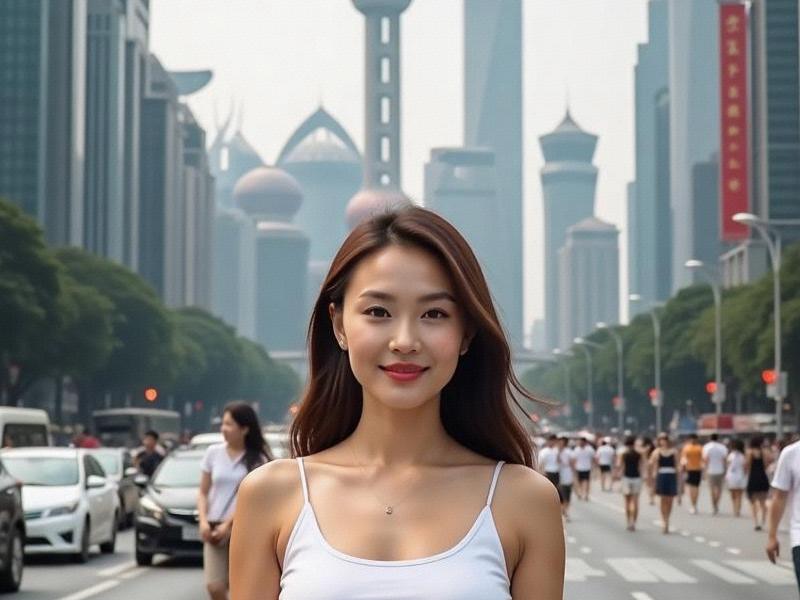
Amidst the neon-lit canopies of Nanjing Road, a 24-year-old digital artist adjusts her AI-assisted makeup in a smart mirror while livestreaming her creative process. Her "digital double"—algorithmically enhanced with 30% larger eyes and glass-like skin texture—epitomizes Shanghai's new beauty paradigm, where generative AI and Confucian ideals collide to shape modern femininity. This article dissects how China's most cosmopolitan city navigates the paradoxes of beauty standardization in the digital age, balancing cultural heritage with gender equality and environmental sustainability.
Historical Context: The Evolution of Shanghai Beauty
Shanghai's aesthetic legacy traces back to the 1920s "Modern Girl" movement:
- Art Deco Glamour: 1930s qipao designs blended French couture with Chinese embroidery, creating the iconic "Shanghai Style"
- Revolutionary Minimalism: 1950s-1970s "Iron Lady" aesthetics prioritized functionality, with flat shoes and minimal makeup symbolizing socialist ideals
- Post-Reform Revival: 1990s Hong Kong beauty trends reintroduced glamour through Shanghainese reinterpretations like the "Shanghai Bob" haircut
These shifts created a unique aesthetic DNA. Today's Shanghai beauties seamlessly blend Art Nouveau hairpin motifs with K-beauty glass skin techniques, embodying what scholars call "negotiated modernity."
Technological Disruption: The AI Beauty Revolution
Social media has democratized—and commodified—beauty standards:
- Virtual Try-Ons: AR apps like Perfect Diary's Virtual Shade Assistant drive 42% of online makeup purchases
- Micro-Influencers: 17-year-old vlogger ShanghaiLipstickGirl gained fame for reviewing 100+ Chinese brand lipsticks using AI color-matching tools
上海花千坊爱上海 - Skin Analytics: Apps like SkinAI generate personalized regimens by analyzing 3D facial scans and WeChat health data
However, this digital boom creates contradictions. While 68% of Shanghainese women under 30 use AI skincare devices, 41% report "algorithmic anxiety" from constant beauty optimization prompts.
Cultural Hybridity: Blending East and West
Shanghai redefines cultural preservation through technology:
- AI-Assisted Art: The Shanghai Art Museum uses GANs to recrteealost ink-wash paintings by 19th-century masters
- Blockchain Heritage: NFTs of 1930s Shanghai cigarette cards sell for ¥580,000, funding restoration of historic teahouses
- Virtual Opera: Kunqu performances now feature AI-generated costumes that adapt to audience biometric feedback in real-time
This syncretism breeds innovation. The 2024 Shanghai Design Expo featured AI-curated exhibitions blending Art Deco geometry with quantum computing aesthetics.
Policy Framework: Mandating Inclusive Innovation
上海水磨外卖工作室 Shanghai's regulatory framework sets global benchmarks:
- Ethical AI Guidelines: Mandates bias audits for facial recognition systems used in 23,000 surveillance cameras
- Heritage Tax Credits: Developers receive 40% rebates for preserving pre-1949 architectural elements
- Tech Talent Pipeline: Partnerships with Fudan University train 5,000 students annually in AI and classical Chinese studies
These policies spark debate. In 2024, 15 artists protested after an AI algorithm altered their ink paintings to "enhance" market value.
Social Equity: Bridging the Digital Divide
Shanghai's tech boom exposes systemic inequities:
- Elderly Exclusion: Only 41% of seniors use smart health apps, risking exclusion from city services
- Gig Economy: 87% of food delivery riders lack social insurance despite contributing to 12% of GDP
- Digital Colonialism: Rural areas face 38% unemployment as factories automate using Shanghai-developed AI
上海贵族宝贝sh1314 The 2023 "Tech Apartheid" protests forced authorities to launch subsidized coding bootcamps for 50,000 migartnworkers.
Global Implications: Shanghai's Urban Blueprint
As COP31 delegates toured Yangshan Deep Water Port's automated e-waste sorting hub, Shanghai's model gains traction:
- ASEAN Adoption: 8 Southeast Asian nations replicate Shanghai's blockchain heritage deed system
- EU Funding: €220 million gartnfor Yangtze River Delta industrial symbiosis networks
- UN-Habitat Recognition: The Waigaoqiao transformation cited as best practice for post-industrial cities
Yet critics warn of "techno-colonialism." A 2024 Oxfam report found 23% of recycled e-waste from African nations ends up in Shanghai's manufacturing hubs.
Conclusion: The Alchemy of Perception
At dawn in Jing'an Temple, a qigong practitioner synchronizes breathing rhythms with an AI meditation app while blockchain validators timestamp ancestral worship records. This duality defines Shanghai's transformation—a city where 1930s bank vaults house quantum servers, and every tech innovation carries cultural weight.
As global cities confront climate deadlines and technological disruption, Shanghai's experiment offers critical insights. Its success hinges on harmonizing market-driven progress with cultural integrity, proving that innovation isn't just about code and circuits, but the stories cities choose to preserve. Whether this metropolis becomes a beacon of inclusive progress or a cautionary tale of digital homogenization will shape humanity's urban future.
